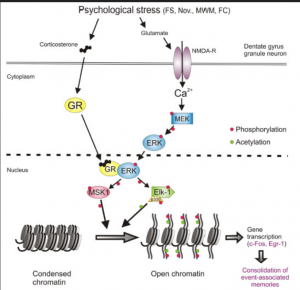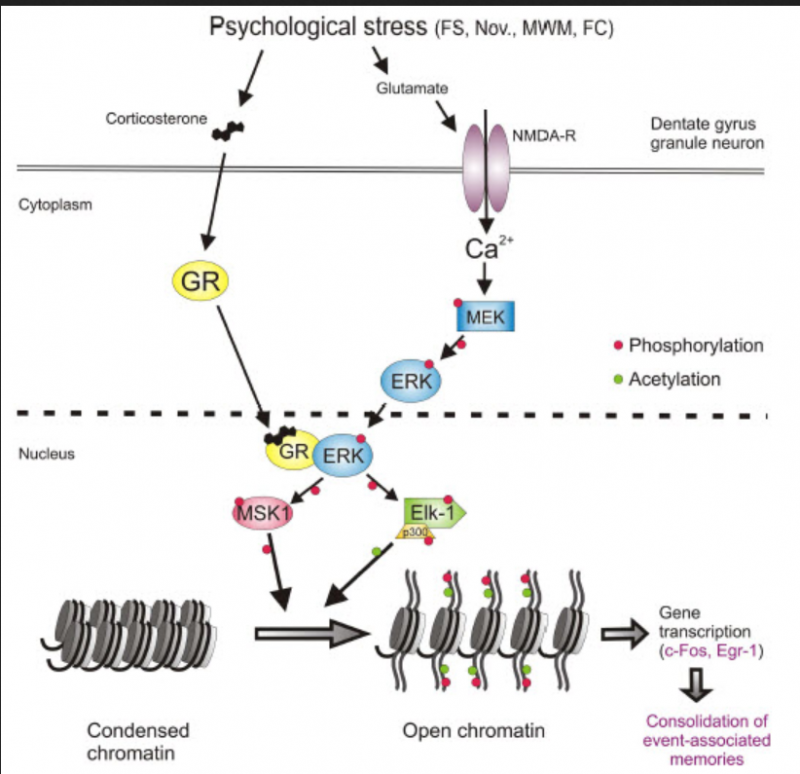Post-traumatic stress disorder (PTSD) is a complicated psychological disorder. While typically associated with army veterans, the disorder is actually common among people who have experienced other horrors, like heinous crimes or natural disasters. What follows is a traumatic reliving of the event. People with PTSD may experience flashbacks, nightmares, unwanted thoughts or memories, and a sense of general anxiety. Symptoms can appear immediately after or may take years to appear. To make things worse, people do not always seek help after the traumatic event, allowing symptoms to worsen.
According to Johannes M.H. Reul, PTSD is really a negative side effect of human’s amazing ability to create strong associations. People associate what would be a neutral stimulus so strongly with a traumatic memory that it impairs daily functioning. However, there is hope to this. PTSD is associated with memory and memory has a biological pathway.
When we experience a stressful event, our bodies release corticosterone. Corticosterone then binds to glucocorticoid receptors (GR). GR then activates extracellular receptor kinase (ERK). Activated ERK can do one of two things: activate mitogen stress kinase 1 (MSK1) or activate Elk-1 by removing a phosphate. Eventually, it will do both.
You might remember from your biology class that our DNA is very long, so long that if all the DNA in your all of your cells was stretched out it would wrap around the solar system, twice![i] To keep our cells to a reasonable size, DNA is wrapped around molecules called histones and condensed into structures called chromatin. MSK1 and Elk-1 unroll DNA (though not all of it at once). This allows for transcription, which makes proteins c-Fos and Egr-1. These proteins work closely with a variety of other mechanism like the NDMA receptor in order to create associations.
[i] How Long is Your DNA? https://www.sciencefocus.com/the-human-body/how-long-is-your-dna/.
While c-Fos and Erg-1 work with NMDA receptors, the NDMA receptor is also part of the memory association process. Glutamate binds to NMDA receptors. This adds a phosphate to MEK, which in turn passes it on to ERK.

Fig. 1. Above is a diagram from the article that outlines the mechanism of memory association.
All of this takes place in specialized neurons within the hippocampus. These neurons are called granule neurons. Unlike neurons in other regions of the brain, these can die off and divide. This is great news for making new memories and associations.
All of this science was discovered very recently, within the last 30 years. Scientists first began to study this mechanism in the 1980s, but it was not until the early 2000s did they finally identify a mechanism. Most of the research was done using mouse models. However, you cannot really give a mouse PTSD. Though, we can identify and induce anxiety in mice. Since anxiety is a symptom of PTSD, we can use anxiety in mice to study PTSD and related disorders.
There are several ways to induce anxiety or stress in mice. One common way is the swim test. A mouse is placed in a pool that has no exit. The mouse frantically searchers for an anxiety, but eventually realizes that there isn’t one. The mouse then goes limp and helpless before being scooped up by a researcher. Mice who undergo this test multiple times eventually spend less time swimming. This retesting is highly dependent on stress hormones. Mice who were given blockers to GR receptors spent more time swimming in the retest[i].
Implications
The article is very technical in its nature and in the descriptions, likely because Johannes M.H. M. Reul were only discovering the pathway, not a connection or implication like other articles discussed on this blog. The authors mention that it took them nearly three decades to find this pathway. This is fairly new science, so it is difficult to pinpoint the exact implications of this study.
Since we know the pathway, it seems plausible to create a drug that acts on an element of this pathway, therefore eliminating or preventing PTSD. However, that is likely not possible. All of this transcription process happens very quickly, less than 15 minutes after the event. People who suffer from PTSD often are not aware of or get treatment for their symptoms until months or years after the event.
Additionally, there is also an ethical side to this. While stress can be bad, it is essential for learning. I’m sure we can all think of a time where we learned something through stress. There is even a common phrase for it in the English language: “learning something the hard way.” Creating a drug that acts on this pathway could have unintended consequences and limit a person’s normal ability to learn. It would be better to have a patient relearn and un-associate everyday things with the traumatic memory.
PTSD is unique among psychological disorders in that it has a direct cause. Disorders like depression and generalized anxiety disorder can affect anyone and be triggered by a number of different things. PTSD is always triggered by some traumatic event. This makes it difficult to study. We cannot expose people to a traumatic event and study them afterwards. This is bad for two reasons: first, we cannot expose anyone to a psychologically harmful event for ethical reasons and second, not everyone who experiences a traumatic event shows signs of PTSD. Exactly why some victims of traumatic events get PTSD and some do not is currently unknown. Women in general are more likely to get PTSD, but this maybe due to the fact that women are more likely to be victims of crimes like rape and assault. We know that there is some genetic basis for anxiety (a common symptom of PTSD and the one symptom that researchers used in testing), so there may very well be some genetic factor with PTSD. However, there is not much that can be done to prevent, except stopping the traumatic events that cause PTSD like rape, war, and assault.
Overall, PTSD is a unique psychological disorder. The disorder is really a side-effect of human’s amazing ability to make associations. However, these associations become so strong that it affects our everyday functioning. It is difficult to study treatments of it because we cannot ethically give a human PTSD. We can induce anxiety in animals, but this is not entirely the same as PTSD, but a mere symptom of it. However, we ought not to shy away from studying disorders like PTSD simply because they are complicated. If anything, their complications show us something about the human condition. We are so good at making associations and learning that sometimes it harms us. But, there is no reason that this amazing ability cannot be used fo
[i] Johanes M. H. M. Reul. Making memories of stressful events: a journey along epigenetic, gene transcription, and signaling pathways. Frontiers in Psychiatry. Vol. 5. Jan. 2014.
